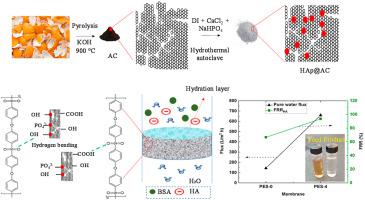Chemosphere ( IF 8.1 ) Pub Date : 2021-08-03 , DOI: 10.1016/j.chemosphere.2021.131799 Parashuram Kallem 1 , Mariam Ouda 2 , G Bharath 3 , Shadi W Hasan 1 , Fawzi Banat 1

|
Hydroxyapatite-decorated activated carbon (HAp/AC) nanocomposite was synthesized and utilized as a nanofiller to fabricate a novel type of polyethersulfone (PES) nanocomposite ultrafiltration (UF) membranes. Activated carbon (AC) derived from orange peel was synthesized by low-temperature pyrolysis at 400 °C. A hydroxyapatite/AC (HAp/AC) nanocomposite was developed by a simple one-pot hydrothermal synthesis method. The UF membrane was fabricated by intercalating HAp/AC fillers into PES casting solution by the non-solvent induced phase separation (NIPS) process. The prepared membranes exhibited a lower water contact angle than the pristine PES membrane. The hybrid membrane with 4 wt% HAp/AC nanocomposite displayed 4.6 times higher pure water flux (~660 L/m2 h) than that of the pristine membrane (143 L/m2 h). In static adsorption experiments, it was found that the amount of humic acid (HA) and bovine serum albumin (BSA) adsorbed by the HAp/AC-PES hybrid membrane was much lower than that of the original membrane due to the electrostatic repulsive forces between them and the surface of the membrane. Irreversible fouling was reduced from 33 to 6 % for HA and from 46 to 8 % for BSA after HAp/AC was incorporated into the PES matrix. After 7 cycles of water-BSA-water, the HAp/AC-PES hybrid membrane maintained a high pure water flux of 540 L/m2 h with an excellent flux recovery ratio (FRR), demonstrating the long-term stability of the membranes. The developed UF membranes outperformed the original PES membranes in terms of permeability, selectivity, and antifouling.
中文翻译:

与羟基磷灰石装饰的橙皮衍生的活性炭纳米复合材料结合的超滤膜具有增强的透水性和抗污染性能
合成了羟基磷灰石装饰的活性炭(HAp/AC)纳米复合材料,并将其用作纳米填料来制造新型聚醚砜(PES)纳米复合超滤(UF)膜。通过在 400 °C 下低温热解合成源自橙皮的活性炭 (AC)。通过简单的一锅水热合成方法开发了一种羟基磷灰石/AC(HAp/AC)纳米复合材料。超滤膜是通过非溶剂诱导相分离 (NIPS) 工艺将 HAp/AC 填料插入 PES 浇铸溶液中制成的。制备的膜表现出比原始 PES 膜更低的水接触角。含有 4 wt% HAp/AC 纳米复合材料的混合膜的纯水通量 (~660 L/m 2 h) 是原始膜 (143 L/m 2 h) 的4.6 倍2小时)。在静态吸附实验中发现,由于HAp/AC-PES杂化膜之间的静电排斥力,HAp/AC-PES杂化膜吸附的腐殖酸(HA)和牛血清白蛋白(BSA)的量远低于原膜。它们和膜的表面。在将 HAp/AC 加入 PES 基质后,HA 的不可逆污垢从 33% 减少到 6%,BSA 的不可逆污垢从 46% 减少到 8%。经过7次水-BSA-水循环后,HAp/AC-PES混合膜保持了540 L/m 2 h的高纯水通量,并具有优异的通量回收率(FRR),证明了膜的长期稳定性. 开发的 UF 膜在渗透性、选择性和防污性方面优于原始 PES 膜。











































 京公网安备 11010802027423号
京公网安备 11010802027423号